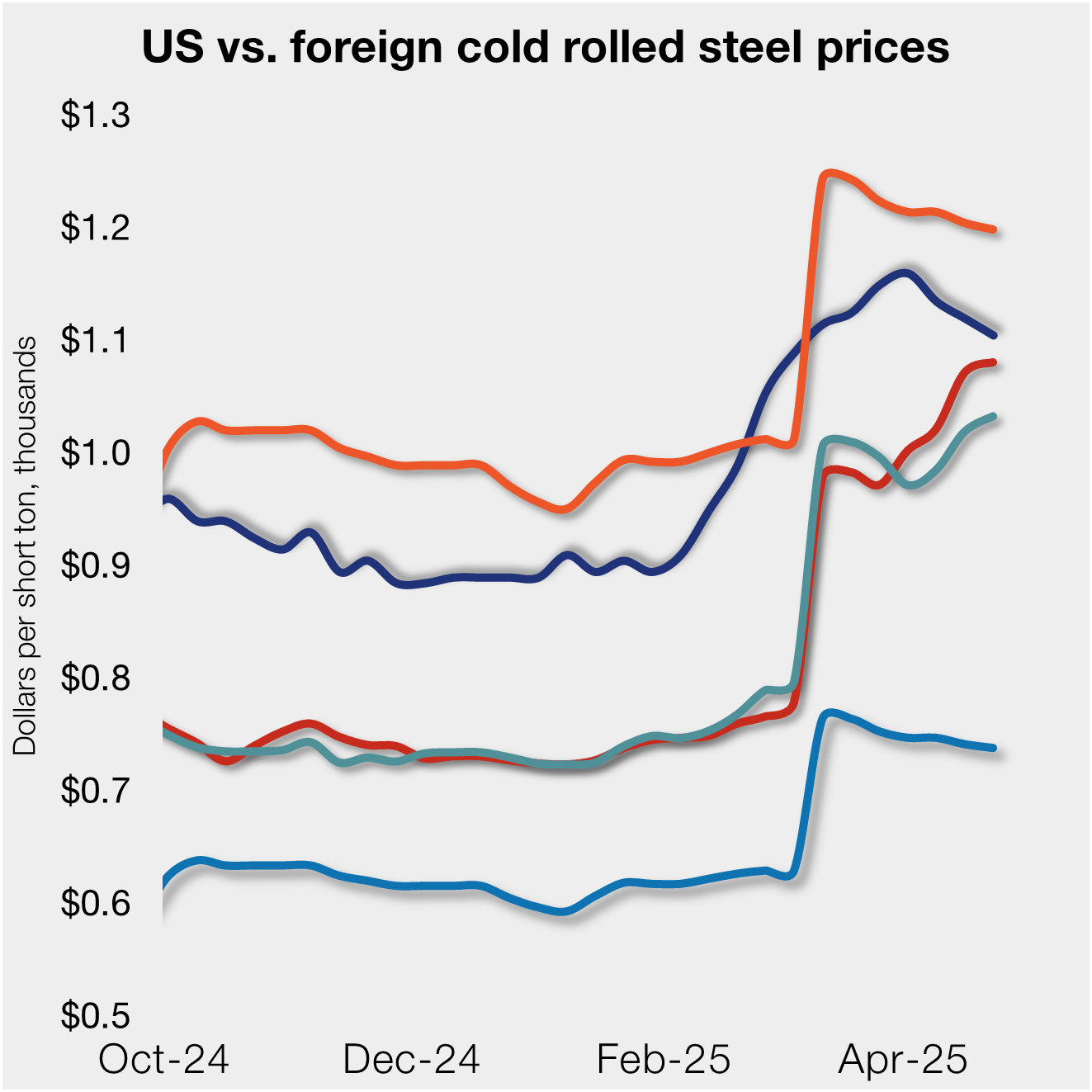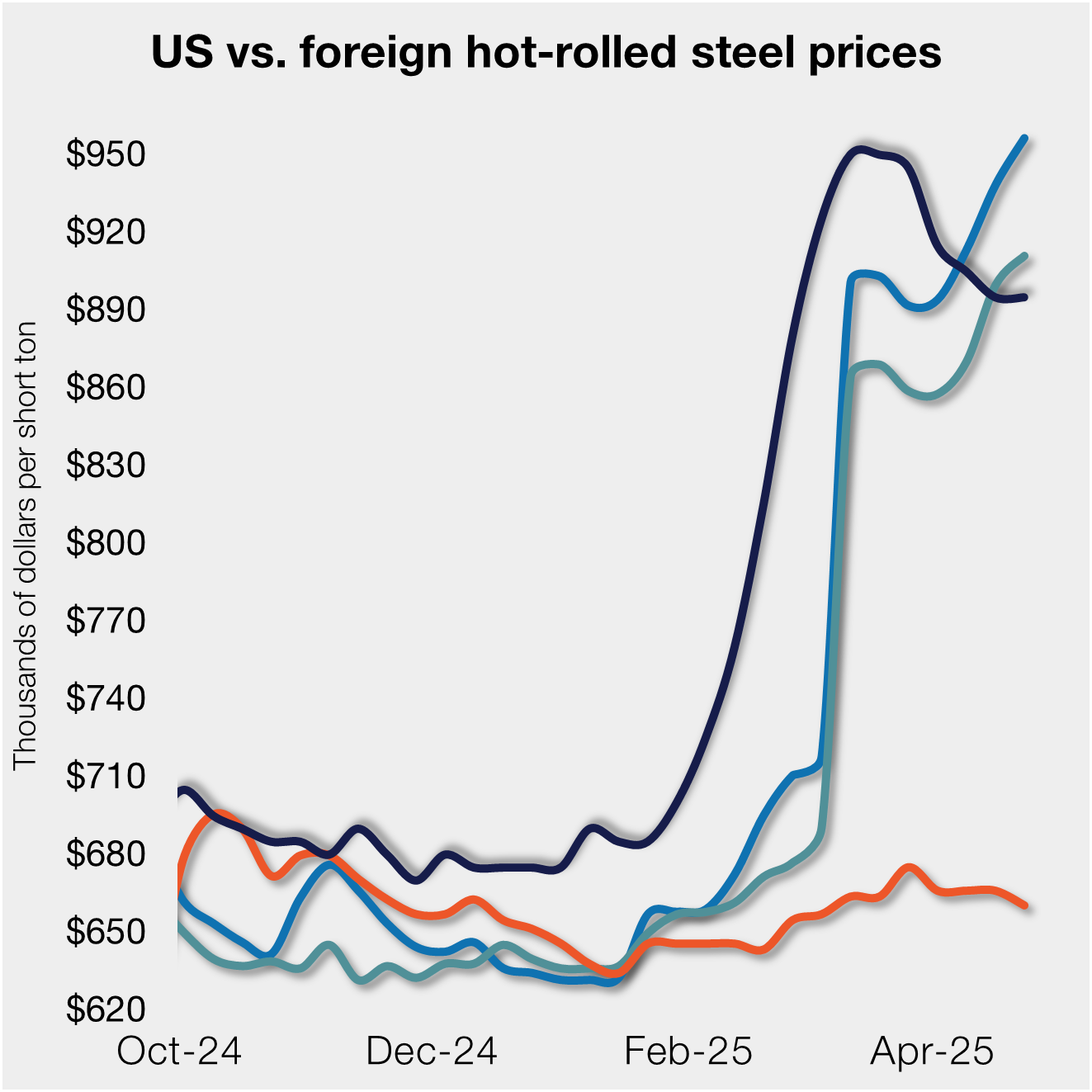Steel Products

Reaction From Steel Buyers on Section 232 Steel Tariffs
Written by John Packard
March 13, 2018
It is still early, but Steel Market Update is already collecting comments and opinions on how the Section 232 steel tariffs are going to affect existing business in the United States. We heard everything from allocation stories to a few companies that reported higher prices but no customers for that higher priced steel.
“This is a negative for the steel mills,” is how one service center executive began when speaking to Steel Market Update earlier today. “NLMK withdrew from the market, and other mills have raised prices again with coated steel now being offered at $50.50/cwt base price levels.” The executive said he objected “pretty strongly.” Especially since he was unable to sell any material last week at $47.00/cwt base price levels. “If I am going on allocation, I expect to be able to put $70 on it and sell it and I can’t do it as customers won’t pay the price.”
One trader told us that those countries with duties will lose out to those with exclusions and eventually they will all lose out to the domestic steel mills in the U.S. and Canada. The Mexican mills have precious little to sell as they are booked solid.
Here is how service centers, wholesalers and manufacturing companies responded today to our question: How have the Section 232 tariffs affected your business?
“So far, just preparing on the material side. A bit of resignation to the possible “New World Order,” however. At the end of the day, if prices go up and stay up, it just means our prices go up, as well. Here’s hoping cooler heads prevail and we get passed some of this. Not having a reason for today’s Tillerson announcement doesn’t bode well for the “cooler heads” thought, though.” Agricultural Related Manufacturing Company
“23![]() 2 has affected our business as everyone is panic buying. Prices are dramatically higher, but people fear shortages and are willing to pay the prices.” HVAC Supply House
2 has affected our business as everyone is panic buying. Prices are dramatically higher, but people fear shortages and are willing to pay the prices.” HVAC Supply House
“The tariffs have and will affect us from a supply standpoint. Our fear is that they could affect demand in a negative way in the second half and beyond.” Plate Service Center
“It will get worse before it gets better. I don’t think it is sinking in – especially to those not around in 2004 – that we are facing a real shortage in the near future. [Foreign offers] only from Canada and Mexico. The other foreign suppliers are still pretty confused about how to quote.” Service Center
“Not affected dramatically thus far. However, customers are beginning to balk at the higher prices. I see no alternative for them near-term, but we are starting to hear the negative feedback and ‘noise’ about such high prices and the rapid pace of increases.” Service Center
“For all material types, we are currently not actively shopping for spot tons as our contracts have us fully covered. Our main concern right now is where this market will be when we have to start negotiations and where it will be when we finish.” Manufacturing Company
“Not really affected—there has been a little pickup in business. Like clockwork, the domestic mills went up 16 percent-ish overnight.” Manufacturing Company
“Service center plate inventories are in very bad shape – holes everywhere. Mill lead-times are out into May/June. June books aren’t even opening yet. Second quarter is going to be worse than I predicted. It’s going to be blood in the streets on plate. Hearing that ‘some service centers’ are hoarding and holding back inventory off their books for a higher payday in Q2.” Plate Service Center
“Not sure we really know yet…customers are afraid of the price they will need to pay.” Manufacturing Company
{loadposition reserved_message}
“Not affecting us at this time (spot customers are different story as they are in sticker shock and denial) and I really do not anticipate any major effects. We have been able to raise prices and increase margins. On the profit side, I am anticipating big months in April and May. In my mind, there is still a lot to play out with the 232 final outcome.” Service Center
A large service center group told SMU, “We’re hearing the traders/importers are looking at the math now. Hopefully by the 23rd they will know what the new rules are and most should be able to offer imports at a price that equals domestic, even after paying the duty. If you look at the input cost, I think many countries would see it beneficial to sell to the U.S. market at current levels.” They continued with their thoughts on how Section 232 is affecting their business: “It created panic and acute overreaction in the market. The domestic mills are currently reaping the benefits of consumer fears and exploiting them artfully.”
A manufacturing company told us, “We are very concerned there will be retaliatory actions by foreign countries that will affect our exports. Short term, imports will be stifled, but then will start coming back into the market. The effect will be little change in import quantities, but the market price will have jumped. This will cause domestic manufacturers to be non-competitive to foreign sources for the finished product. Thus, in the long term, we will hurt our domestic manufacturing base.”
The manufacturer continued: “We’re unable to secure tons from Mexico now as the large service centers have swooped in and taken any available tons. I’m not able to procure all the tons needed for my customers currently. Business sectors are still very strong. We’re looking at Canadian offers as supply for southern mills is very tight and will be until summer. [Foreign buys] are still in discussion, but no firm offers yet. Some mills are sharing some tariffs already to keep steel flowing in. I expect more of that moving forward. Can you be accused of dumping steel while at 25 percent tariff?”
A large OEM told us late this afternoon: “It’s hard to properly comment on the domestic market right now. There’s an obvious air that prices are skyrocketing and the mills will be aggressive. Our experience over the past week, however, is that the mills have been rather agreeable to review tons with very reasonable lead times and with very non-opportunistic transaction pricing. I suppose this may change, but even mills we’d expect to have an attitude have suggested available capacity and a willingness to offer tons for consideration.”
This manufacturing company continued with, “The import market is a mixed bag currently. Suppliers are still wrapping their heads around agreements in place and what the tariff impact may be. In a number of instances, calculating the tariff has still been a question mark, as a trader may not have access to all proper costs required to properly interpret the tariff calculation. For new business, the traders have all expressed that they will be adding the tariff onto the FOB mill / ex works cost. We’d expect this and understand in no uncertain terms that any tariff effect will need to be passed along and collected from the trade in order that we remain whole. The mill won’t eat it, the trader won’t eat it and we can’t eat it…there’s simply not profit available to compress margins…so in the end it will have to be passed through to the consumer. We also believe that certain traders may attempt to take liberty during this current state of confusion and market upheaval, but those kinds of things have a way of sorting themselves out and we’re not going to be concerned with it for now.”

John Packard
Read more from John PackardLatest in Steel Products

US rig count up, Canada declines
Oil and gas drilling activity was mixed this week, according to Baker Hughes. US rig counts expanded for a second straight week, while Canadian activity continued its seasonal slowdown of eight consecutive weeks.

US, offshore CRC prices continue to diverge
US cold-rolled (CR) coil prices declined again this week, slipping for a third straight week. Most offshore markets did the opposite, moving higher this week.

S232 lifts EU HR price over US, Asian HR still well behind
Domestic hot-rolled coil prices were flat this week after dropping for four straight weeks. Most offshore markets bucked the trend and gained ground.

SMU Steel Demand Index dips into contraction
SMU’s Steel Demand Index has moved into contraction, according to late April indicators. The slowdown comes in response to growing tariff uncertainty after the index reached a four-year high in late February.

Nucor selects Fives Group for new galv line at CSI
Nucor Corp. has tapped Fives Group as its partner in designing and manufacturing the new continuous galvanizing line being added at its California Steel Industries (CSI) joint venture in Fontana, Calif.
